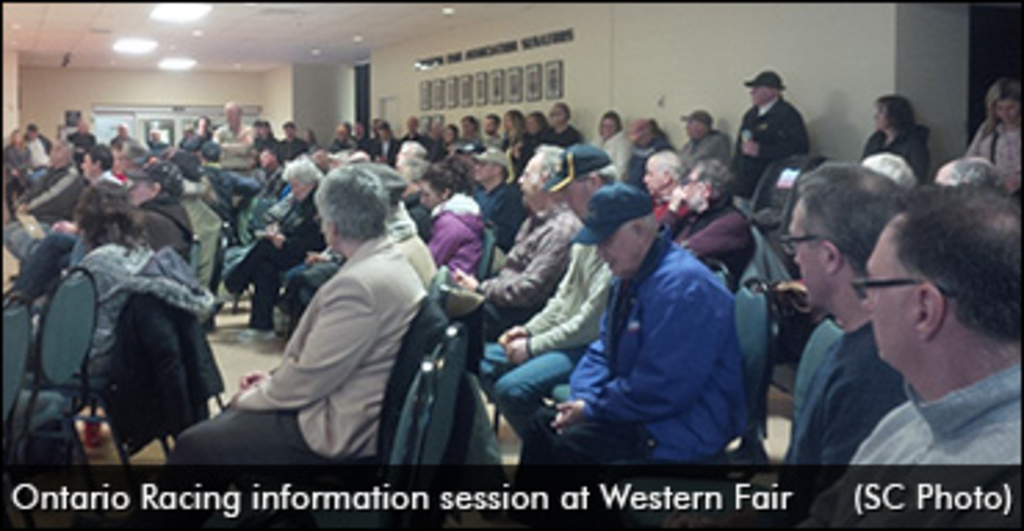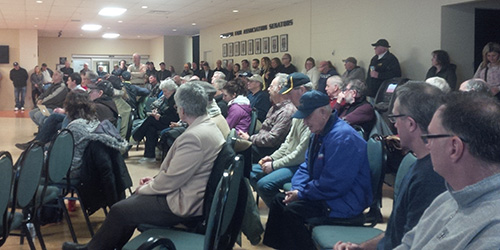
 The first of two information sessions hosted by the new Ontario Racing Association (ORA) was held on Tuesday afternoon at Western Fair in London.
The first of two information sessions hosted by the new Ontario Racing Association (ORA) was held on Tuesday afternoon at Western Fair in London.
The session was designed to discuss the new responsibilities of ORA, Ontario Lottery and Gaming and the Alcohol and Gaming Commission of Ontario beyond April 1, 2016. According to ORA's Executive Director John Snobelen, ORA will take over administration of the HIP program from OHRIA, which will effectively dissolve come April 1.
"It's evolution," ORA's Executive Director John Snobelen told Trot Insider after Tuesday's session. "OHRIA was set up almost 20 years ago and it had particular kinds of tasks, and the government now really needs an articulate, authoritative voice on racing. And the industry of racing needed to help frame the racing program going forward, needed to be a real partner. So that has to be more robust, has to be of a more significant management capacity, and as we transition out of the ORC model government has asked us to stand up an industry association, make sure it can take on those responsibilities and then build a governance model for it that more accurately reflects the industry as we now know it."
While the actual individuals that will comprise ORA and its Board of Directors have yet to be finalized, Snobelen shed some light on how that not-for-profit entity will be comprised.
"We need to have a Board of Directors, and an Executive Committee...so a Board that creates an Executive Committee," said Snobelen. "The model that we've put out and that we'll try to work with people on populating is a Committee-based Board of Directors...so the chairs of committees sit on the Board of Directors..by the way, with some external focus too so some external seats that haven't been there before."
Another aspect of the information session gave participants an opportunity to offer feedback on the province's racing program. As the industry heads into its third year of a five-year plan with Ontario's government, Snobelen noted that the original idea was to start looking past that five-year plan after year three. However, in order to give participants the most time to plan to have a clearer idea of what the province's industry would look like after 2018, Premier Kathleen Wynne gave instruction to expedite that process.
Two of the issues facing Ontario's horse racing industry today, according to Snobelen, are horse population and the value of the Canadian dollar. These are crucial elements and a new reality that he feels a plan for racing going forward must face.
"First, in the immediate future, we've got to make sure that the circumstances we find ourselves in -- horse supply, currency -- all of real those things that make a difference on the ground, that our racing program reflects those inputs. Secondly, in the long run, the government is committed to maintaining a robust horse racing industry in the province way past 2018. And the question now is how. What's that funding modality, where are the responsibilities, who does the racing program...they want to lean on an industry association to provide guidance on that, and that's what they've asked us to do. I think that's good news from an industry point of view. Clearly there's nobody politically in the province that wants to see the termination of horse racing."
While acknowledging that industry participants most certainly require stability to plan for the future, Snobelen sees a new plan for racing needing is some built-in flexibility to quickly change, if needed.
"Our racing plan has got to be dynamic: long enough that people can plan for it but dynamic enough to meet the needs as they change year-to-year. Heck, they change month-to-month...so we need to have that ability to recommend adjustments to the program on a regular basis, including in-year.
"One of the things we haven't had before -- because our industry association's never been well-funded; it just hasn't been, it's not by design -- we haven't had any ability to do jurisdictional scans, we haven't been able to look outside Ontario and say what's going on in the jurisdictions we compete with, and we need to build that capacity...we need to have enough funding to do some forward-thinking planning."
A hot topic of discussion at this information session revolved around a proposal to revamp the racing circuit in southern Ontario, most notably eliminating racing at Dresden Raceway, Hiawatha Horse Park and Leamington Raceway and adding more racing to Western Fair.
Mark Beaven, co-author of the report told the 100+ people in attendance that his plan might not be perfect but it's most certainly a discussion point. He welcomed discussion and constructive criticism to the ideas presented and welcomed anyone else to come forward with a better model if they felt his needed some revisions.
Some of the discussion from the floor also centered around transfer payment plans that the government currently holds with the racing industry. Snobelen confirmed during the session and again after that those won't be changing.
"The government has no interest in unilaterally changing transfer payment plans. They would do it if they would look at changes in those transfer payment agreements -- there are conditions that can be changed -- but certainly by agreement," said Snobelen. "So if there's a trading of race days amongst tracks, if there's a purse change that the industry can recommend, they'd surely look at that and agree to it if it made sense, but they don't want to unilaterally go and do that."
The premise of a single horsemen's group was also discussed, insomuch as how the process started and was then unceremoniously abandoned. While Snobelen and OLG's Michael Keegan both acknowledged it wasn't a pressing issue for government as this time, Snobelen did guarantee OHHA's Ken Hardy and Brian Tropea that he'd revisit the idea if for nothing else than ensuring horsemen's benefits are funded.
"I think Brian's comments are that there needs to be some certainty for the people in the horse racing industry that the benefits they depend on from the horsemen's groups are going to be there, and are going to be funded and how they get funded needs to be structured," Snobelen told Trot Insider. "I think we have a role to play in making sure that happens. And then, if there's a way of helping to facilitate the political side, if you will, of those groups getting together we'd be happy to do that."
Snobelen wouldn't go so far as to say that the concept will be resurrected, although it was in the original plan for Ontario's horse racing industry that he, Elmer Buchanan and John Wilkinson penned for the government in 2012.
"I'm always stuck at the place of you don't want to dictate to -- and government shouldn't dictate to -- horsepeople on how they get represented. So the government there was in the awkward spot of dictating to industry groups on how they should work together. We've got some models for how that doesn't work. On the other hand, there's no wall between one track and another track and common representation just makes good sense."
Given that the new ORA will possibly have some representation from a Standardbred horseperson's group, Snobelen recognizes that some form of unity would be ideal for this organization going forward.
"I think it's obvious that the more wired together they are the better it is for everybody. The overall message here is that we've got to have one voice, and we're better together -- and that's the whole industry, not just standardbred horsepersons but everybody and we need to be able to solve that problem to solve a bigger one."
Snobelen was very pleased with the turnout and the decorum displayed at this first information session and appreciated the time people took to attend. He took notes throughout the session and felt the comments from the audience were great, considering them "real progress" in terms of his own thinking.
Next, he and Keegan have to fulfill some commitments to the racing industry that the duo made. One of those was to be more transparent and do a better job of getting information out to the industry. Among that information will be key performance indicators that government will be tracking to ensure their partnership plan with racing is where it needs to be.
"People need to have a better, clearer understanding of the conditions of the industry in order to be able to evaluate ideas. I think that we need to have a set of metrics that we compare various options -- higher purse levels, changes in venue, all those sorts of things -- we'll have to have metrics that we'll have to build in order for those to be evaluated. We can do that. We will do that and we'll make it publicly available.
"We also, though, need a different way of collectively doing decision making, so I'm going to go out and look at what are those decision making trees that are available to us now that might not have been five years ago and how do we incorporate them. Look, we could force a decision pretty quickly, I don't think that's useful...and we've got to do this every year now until forever so let's get it right this time."


